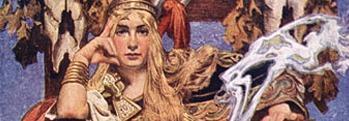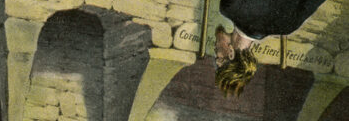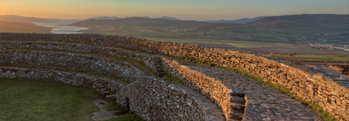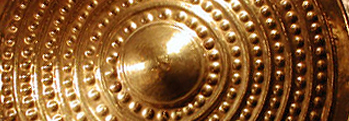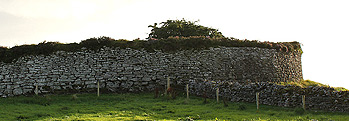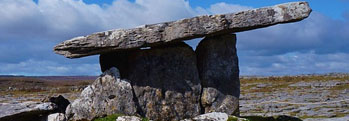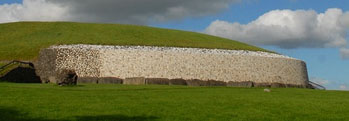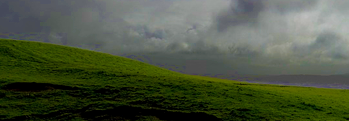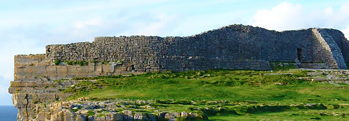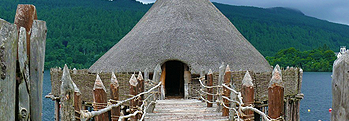Lough Gur
Irish and Celtic myths and legends, Irish folklore and Irish fairy tales and Legendary Places in Ireland
One of the richest places of legend in Ireland
 Ireland's bones are made of stories, you can hardly step over a rock or walk past an old mound but if it could speak, it would tell you tales you could hardly imagine. But of all the legended glens and fields misty with memory in this ancient nation, there are few with as many secrets hidden in their depths as Lough Gur in county Limerick.
Ireland's bones are made of stories, you can hardly step over a rock or walk past an old mound but if it could speak, it would tell you tales you could hardly imagine. But of all the legended glens and fields misty with memory in this ancient nation, there are few with as many secrets hidden in their depths as Lough Gur in county Limerick.
Situated between what we today call Herbertstown and Bruff, it is a lake in the shape of a dragon's mouth yawning wide, although it formed a perfect circle until it was drained for agricultural purposes in the 1840s, which exposed many of the treasures hiding below its waves.
In the middle of this once-circular lake is the hill of Knockadoon, upon which stands the Suideachan Bean-tí, the Housekeeper’s Chair, also called Áine’s birthing chair and the Old Hag’s Chair, which is the seat of the fairy Áine, upon which no mortal may sit without losing their wits entirely!
Nearby can be found the largest Neolithic stone circle in Ireland, Grange stone circle, also known as “Lios na Grainsi” or the “Stones of the Sun”. These were used for rituals and are aligned with the summer solstice, and were the site of great Aenachs, or festivals, where bonfires were lit and sporting events took place.
The lake is surrounded by great dolmens and pillars, ring forts, ruined castles, ancient farmsteads whose outlines can still be seen – the spectacles – and crannógs on their artificial islands, as well as a wedge tomb where once the bronze sickles of the druids shone wetly in the silvering moonlight.
People have lived here from the very earliest times, for six thousand years or more, and they hunted the giant elk whose bones still litter the area. It was said to have been sacred to the Tuatha Áine, daughter of Dagda and brother of Fer Fi who once led the Tuatha. Her legend echoes even to this day, and she is known as the white lady, Bean Fhionn, or the lady of the house, Bean Tí.
Once every seven years she was said to summon a sacrifice to the lake and take them below to her country, as described by Mary Fogarty, born nearby in 1858:
“...some say that in ancient days there was a city where the lake is now, before an earthquake threw up the hills and filled the hollow with water so that the city was submerged. Even now, the peasants say, when the surface of the lake is smooth one may see from a boat, far down and down again, the drowned city, its walls and castle, houses and church, perfect and intact, waiting for the Day of Resurrection.
And on Christmas Eve, a dark night without moon and stars, if one looks down and down again, one may see lights in the windows, and listening with the ears of the mind, hear the muffled chiming of church bells.”
No poet or writer in Ireland will sleep on the shores of that lake, for fear of the visions they might have, or worse, that the lady might take too much of a liking to them! Such is told of the fate of Gearáid Iarla, the third Earl of Desmond, who helped to write the cruel Statutes of Kilkenny, intended to cause division and strife between the Norman invaders and the native Irish. For you see, the invaders were becoming more Irish than the Irish themselves!
He made it illegal to:
- Marry an Irish person
- Adopt an Irish child
- Use an Irish name
- Wear Irish clothes
- Speak the Irish language
- Play Irish music
- Listen to Irish story-tellers
- Play Irish games
- Let an Irish person join an English religious house
- Appoint any Irish clergyman to any church in the English settlement
- Ride a horse in Irish style, that is, without a saddle.
And if that wasn't enough, the man was reputed to be a black magician who sought to bind the Sidhe Áine to his will and to be his mistress by stealing her cloak as she bathed under the starlight. Of course that was never going to end well, and despite his best precautions he was drawn into the lake to become one of the undead, only allowed to gallop wildly around the edge of the lake once every seven years.
The silver horseshoes by which he sought to flee in superstition are now the chain that binds him, for he can never return to the land of the living until they are worn away from the hooves of his horse entirely! Some say he will restore the House of Desmond when he is finished with his midnight rides, but you could be forgiven for doubting it.
Áine herself was said to have been the mistress of no less than Crom Cruach, or Crom Dubh, old black one eye of the many glooms who was worshipped by some in Ireland in times past. And neither did they come to a good end, as with the Milesian King Tigernmas, who perished dreadfully in his dark festivities, along with most of his men!
The largest stone of the one hundred and thirteen in Grange stone circle rears up more than four meters in height and is called Rannach Crom Dubh, or the division of Crom Dubh, and weighs more than forty tons.
Another manuscript tells a tale from the eighth century, when Christianity was almost spread throughout the whole country – but not yet to every last corner! For a king of Munster whose name was Ailill Olom fell asleep on Cnoc Áine during the Samhain festivities, and found all the grass was gone from the hill when he opened his eyes!
Unable to explain this turn of evens, he sought the counsel of a wandering seer, Fergus mac Comáin, who suggested they go back and see if it happened again. Well the king fell asleep but the seer did not, instead hiding himself in the bushes so he was able to see the Sidhe King and Áine come forth from the hill!
The seer wasted no time but hopped out and murdered the Sidhe King, while Ailill Olom came awake and, unable to restrain himself, ravished Áine. In her fury at this assault she, in turn, ripped off his ear, and after that he could no longer be king, for it was forbidden that any man should rule who was not whole in body.
Across from the hill of Knockadoon is another hill, called Knockfennel, which is also said to be hollow, although there is a small opening near the summit which grants access to any with the courage to enter the fairy otherworld. Fires were lit here on Samhain night, and six nights after the sick were brought out to be healed. If they were not healed by the ninth day of the moon they would hear the ceol Sidhe, the Suantraighe, ancient music Áine played to comfort those who were about to die.
Other stories tell of the Bean an Tí sitting upon her throne, having come up from the lake, combing her hair with a beautiful golden comb. A shepherd boy watched from a distance, and when he saw that comb, he knew he had to have it for himself, so he crept up behind her and stole it while her attention was elsewhere!
After that he had a terrible life filled with misfortune and failure, but before he died he ordered that the comb be thrown back into the lake, and so Áine got her comb back.
A poet-harper named Thomas O’Connellan, who died during a feast at Bouchiers Castle around 1700 is buried nearby, and it was written:
..”in that churchyard by Lough Gur’s romantic shore,
where the shamrocks and the ivy every grow
where the wild dove and the raven
like protecting spirits soar
o’er the green graves of silent Teampall Nua”.
But perhaps strangest of all is the finding of the Lough Gur shield, or the sun-shield, which is a magnificent bronze age shield perhaps more than three thousand years old. It is one of a few of the same style found as far abroad as Scotland and Denmark, which tells of a single people united in their ways and beliefs across all of the north and west.
It was, so they say, fished out of the lake with a gaff hook in 1872 by a young man called Cathal Hayes, who traded it to the historian Maurice Lenihan in Limerick for the price of a boat ticket to America. While he was there he kept the company of the Mayor of Boston, who married Josephine Hannon, whose father had been born at Lough Gur, and whose grandson became none other than US president John F Kennedy!
Lough Gur can be found on the map below.
Legendary Places in Ireland
The gift of the gab, as it’s known, is a common thing among the Irish – being able to talk all day about anything and everything, and do it in a way that would have you listen as well. It’s as Irish as red hair and freckles. But what if you didn’t have the gift of the gab, or felt a deficiency of gabbiness? Never fear, al ... [more]
Ireland is a land of many treasures – some are well known while others are known only to a few, like the mysterious stone circles of Beaghmore! In the north of County Tyrone they can be found, at the edge of the Sperrin mountains looking out over the wide countryside below, dating back to the bronze age and earlier, to the time when the Tuath ... [more]
The royal ringfort of Grianán Ailigh was known as the father of every building in Ireland by the Annals of the Four Masters, who also claimed it was first built in the year 1500 BC, in the time of the Tuatha Dé Danann! A mighty place of strength it is and was and may always be, one of the few locations in Ireland correctly marked on a ... [more]
Knockma of the mists is a place wreathed in secrets and myth where they say sleeps the greatest king of the Sidhe, he whose name was Finnbheara! Should you go for a walk around Knockma Hill, pay close attention to that which you cannot see – a warm breeze meant a good fairy was passing by, and a sudden shiver meant an evil one was close! J ... [more]
Nine is a mystical number in Irish folklore, being thrice three, itself known from ancient times as a mysterious symbol, and so should you happen across nine stones, you would do well to be extra careful! For who knows what might lie sleeping just below the surface. And such a place can be found on the saddle between Sliabh Bán, the White ... [more]
Once upon a time there were many kingdoms in Ireland, and many kings, or perhaps they would have been better known as chieftains, but kings they were for all that. As time went by each of these kingdoms fell and were joined one into the other, but yet a single kingdom still remains in the farthest north and farthest west of the country, and this is ... [more]
Ireland's bones are made of stories, you can hardly step over a rock or walk past an old mound but if it could speak, it would tell you tales you could hardly imagine. But of all the legended glens and fields misty with memory in this ancient nation, there are few with as many secrets hidden in their depths as Lough Gur in county Limerick. S ... [more]
There are tens of thousands of round stone forts in Ireland, some say as many as fifty thousand, if you can believe it, and one of the finest examples we have is at Kilcashel in County Mayo, which comes from the Irish Coill an Chaisil, the woods of the stone fort. Almost perfectly circular in construction, with thick walls two broad men could walk ... [more]
Scattered throughout the Irish countryside are hundreds if not thousands of holy wells, almost all of great antiquity, even predating Christianity. They can take almost any form and show up in any place, shimmering in the shadow of engraved stone monuments, in lapping sea caves where the fresh and salt waters mingle twice a day, as natural springs ... [more]
In county Roscommon there's a place of great antiquity called Oweynagat, which some have mistakenly thought to mean the Cave of Cats, although it has nothing to do with cats - “cath” being the Irish word for “battle” and so it should rightfully be called the battle cave. Indeed it has a long association with the Morrigan ... [more]
The Burren is one of the wonders of Ireland. A rolling rocky landscape of limestone hills and plains, it is marked with history stretching back thousands of years. Nestled in between the limestone slabs are herbs and plants you'd be hard pressed to find elsewhere, hailing from places as far afield as the Arctic and the Mediterranean, kept warm ... [more]
Older than Stonehenge and the great pyramids of Giza stands Newgrange, the heart of legends and mysteries stretching back five thousand years. Situated along the river Boyne near to numerous other such places like Knowth and Dowth, that very same river where Fionn Mac Cumhaill was said to have first found and tasted the salmon of knowledge, and the ... [more]
The seat of the High Kings of Ireland of old, Tara or Temair as it was known then, is said to have been the seat of a hundred and forty two kings, kingships won by battle, contest and merit, not passed down father to son as in more primitive cultures. One of the most important monuments in the sacred Boyne valley, its history stretches back four th ... [more]
Dun Aengus means "the Fort of Aenghus", and remains one of the most impressive ancient monuments in Ireland, Europe or the world. Perched on the edge of a high and jagged cliff with the grey-green waters of the Atlantic battering below, it gained its name from its original builders, who were called the Fir Bolg, some of the first to arriv ... [more]
Crannogs, the name meaning "young trees" for reasons which aren't too clear, were dwelling places for people in Ireland from the time of the Tuatha de Dannan right up to the seventeenth century. They were built on shallow lakes or pools on top of tree trunks stuck into the lake bottom, piles of rocks, mud and other debris or on natura ... [more]
Croagh Patrick or Patrick's Stack is an important place of pilgrimage for Christians throughout Ireland and the world today, some even walking the ascent in their bare feet as penance for their sins. However it was considered a holy place long before St Patrick came to visit, even though it is said he banished the snakes from Ireland while stan ... [more]
Rising from the ocean a short distance off the coast of county Kerry in southern Ireland, Skellig Michael and its smaller brother rear up out of the Atlantic ocean like jagged grey teeth. Famous poet George Bernard Shaw who visited the place in 1910, called it an "incredible, impossible, mad place" and "part of our dream world". ... [more]




